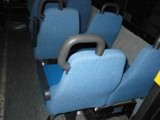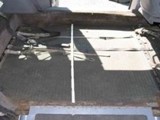(Click on Images to Enlarge)
Seating and securement is the “flip side” of one’s compliance with the physical realities of Newton’s Laws of Motion, and the existence of inertial and centrifugal forces. Because of these forces, every passenger must be seated or secured before the vehicle begins moving. Largely because of their eyeballs and mirrors, and because they control the vehicle’s movement, drivers have complete control over this. In contrast, they do not have control over standees changing positions once the vehicle has begun to move. Nor do they have control over passengers changing seats. So lawsuits where passengers engage in such maneuvers while the vehicle is moving, and where there are no video cameras to capture the action, are challenging gray cases, where both the attorney and his or her expert must dig deep into their mental libraries to extract the maximum precedent value from the facts that are known, on both sides of the table. In such cases, eyewitness accounts of fellow passengers are critical, as is the driver’s distribution of “courtesy cards” to fellow bus passengers. (Not doing so appears like a cover-up, and more than one attorney I have assisted has argued it comprised a form of spoliation.)
Greater complexity occurs on the one mode not equipped for standees, but where passengers need to occasionally stand and walk around the vehicle: Motorcoaches with restrooms. Here, driver vigilance is critical, and the plaintiff’s counsel and expert can (and should) argue that the driver should have kept track of those passengers beginning to move up or down the passenger aisle toward the restroom, and instruct him or her not to if the vehicle is about to exit a freeway ramp, come to a halt at a toll booth, or traffic is suddenly becoming stop-and-go where the driver cannot maintain the following distance of his or her choice (because fellow motorists will immediately cut in front of his or her coach, particularly in merging situations).
There is also an equipment component of this issue. Even on non-transit vehicles where passengers may be moving around, those defining purchasing specifications would do well to “go overboard” in affixing handrails and handgrips to the aisle-side corners of every seatback cushion. In contrast, luggage racks (which most motorcoaches contain) are not designed or constructed to serve as horizontal stanchions like those transit buses possess, and where they exist, they may induce passengers to use them for such purposes. Trolley-façade minibus conversions with horizontal stanchions installed for decorative purposes must be similarly vigilant to not let their passengers ride as standees as they might on a genuine trolley, particularly given the other, even-more-dangerous decorative elements included in most of these conversions, such as the wooden bench seats.
Needless to say, standees should not ride on any vehicles not equipped with both (a) pneumatic suspension systems, and (b) interior stanchions, handholds and other accommodations securely anchored into the vehicle’s structure to ensure their securement. Even so, in a serious collision, even your standees holding on tightly to stanchions are going toward or through the windshield, likely after tearing a rotator cuff. Some things, like it or not, are not the fault of anyone you can likely sue — one reason the word ‘accident’ remains in the dictionary, even if it is a curse word on the plaintiff’s side in court. (And on this side, your experts should know to never utter it.)
Many drivers also induce passengers to stand during their most vulnerable moments — when the bus is decelerating and braking as it pulls into a stop. A safe driver will wait for the vehicle to stop before expecting alighting passengers to leave their seats. Yet given the obscene tightness of many schedules, particularly in transit service, if a passenger “chimes” the driver to stop but, upon approaching it, the driver does not see the passenger already walking toward a door, the driver will bypass the stop. This error results in a considerable number of on-board slips and falls: Inertial and centrifugal forces give quarter to no one.
Forward-facing seats are significantly more safe than side-facing ones — particularly when lapbelts are used. This distinction may sound subtle, but directly and indirectly is an important incident and injury factor, especially in collisions. It is truly amazing how few people in the public transportation field (with the exception of the school bus community) understand that the most important feature that makes a seat safe is the seatback directly in front of it.
Finally, once again particularly where routes are tight, many drivers induce standees during their most vulnerable moments — when the bus is decelerating and braking as it pulls into a stop. Particularly on single-front-door motorcoaches deployed in express service, drivers expect passengers to rise and move forward once they “chime” the driver to stop at their destination. Often drivers ignore the stop if they fail to see this passenger standing and walking forward in their interior, rearview mirror. This practice effectively forces these passengers to take a serious risk, and rise and walk during the worst time on the entire ride that they could. This problem would not be so serious if transit agencies deployed less costly but just as luxurious and comfortable buses for their “express” service. However, because these riders are typically felt to be “choice” riders (and possibly because the purchasing agent’s foreign bank account is periodically swelled), most transit agencies purchase considerably more expensive motorcoaches for this purpose, and without the vertical and horizontal stanchions of transit buses, passengers waltzing down the aisle of a motorcoach while it grinds to a stop can be dangerous. This is an area with a lawsuit just begging for an injunction to rock the defendant into the land of safety and integrity.



